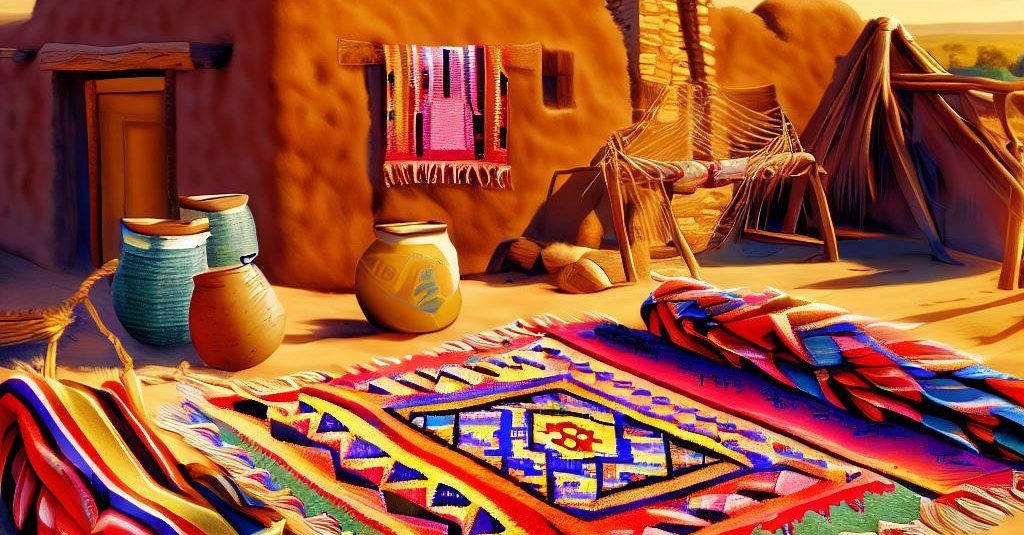Navajo Weaving: A Tapestry of Tradition, Adaptation, and Intertribal Connections
Navajo weaving is a rich and intricate art form that has played an integral role in Navajo culture for centuries. Known for its distinctive geometric patterns and vibrant colors, Navajo weaving reflects the tribe’s spiritual beliefs, history, and worldview. By examining the origins, techniques, and evolution of Navajo weaving, we can gain a greater understanding of the Navajo people’s interconnected histories, cultures, and experiences. This article will also highlight the interactions between the Navajo and other tribes, illustrating the exchange of ideas and techniques that have shaped Navajo weaving over time.
The Origins of Navajo Weaving:
The Navajo people first learned the art of weaving from their Pueblo neighbors around the late 17th century. The Pueblo tribes, particularly the Hopi, were skilled weavers who had developed intricate weaving techniques using cotton as their primary material. The Navajo adopted these techniques and began to incorporate wool into their weaving practices after the introduction of sheep by the Spanish settlers.
Early Navajo weaving was heavily influenced by Pueblo designs and techniques, featuring simple striped patterns made from natural, undyed wool. Over time, the Navajo developed their unique style, incorporating more complex patterns and vivid colors obtained from natural dyes.
The Evolution of Navajo Weaving
Techniques and Looms:
Navajo weavers use a traditional upright loom to create their intricate textiles. The loom, typically made from wood, is designed to be portable and easily disassembled, reflecting the tribe’s historically nomadic lifestyle. Weavers create tension in the warp threads by attaching weights, allowing them to produce tightly woven textiles with fine details.
Navajo weaving is a time-consuming and meticulous process. Weavers use a technique called “weft-faced tapestry weave” in which the weft yarns completely cover the warp threads, creating a smooth and sturdy fabric. This technique allows for the creation of intricate patterns and precise lines that have become hallmarks of Navajo textiles.
Navajo Weaving Techniques and Looms
Types of Navajo Textiles:
Navajo weavers have created a wide variety of textiles throughout history, ranging from functional items such as blankets and clothing to ceremonial and decorative pieces. Some of the most well-known Navajo textiles include:
Chief’s Blankets: Worn by Navajo chiefs and other high-ranking individuals, Chief’s blankets are characterized by their horizontal striped patterns and high-quality materials. Early Chief’s blankets were made from handspun wool, while later examples incorporated commercial yarns in vivid colors.
Serapes: Similar to Chief’s blankets, serapes are large, rectangular shawls that feature intricate geometric patterns. Serapes are often woven with vibrant, contrasting colors, making them visually striking and highly sought after by collectors.
Rugs: Navajo rugs became popular in the late 19th and early 20th centuries, as the tribe transitioned from making functional textiles to creating decorative pieces for the growing market of non-Native consumers. Navajo rugs feature a wide variety of designs, including the iconic Two Grey Hills, Ganado, and Teec Nos Pos patterns.
Pictorial Weavings: These textiles depict scenes, animals, or other recognizable figures, often drawing inspiration from Navajo daily life, ceremonies, and legends. Pictorial weavings showcase the weaver’s creativity and storytelling abilities, making them unique works of art.
Germantown Weavings: Named after the Germantown yarn produced in Pennsylvania and introduced to Navajo weavers in the late 19th century, Germantown weavings are known for their bright colors and intricate patterns. These textiles reflect the influence of non-Native materials and market demands on Navajo weaving.
Intertribal Connections and the Evolution of Navajo Weaving:
Navajo weaving has been shaped by interactions with other tribes and peoples throughout its history. The initial influence of Pueblo weaving techniques laid the foundation for the development of Navajo weaving, while the introduction of sheep and wool by the Spanish settlers greatly impacted the tribe’s choice of materials.
The Navajo people have also been influenced by the designs and weaving techniques of other tribes, such as the Ute, Apache, and Rio Grande Pueblo. These exchanges of ideas and practices have contributed to the evolution and diversification of Navajo weaving styles.
In addition to intertribal connections, Navajo weaving has been influenced by non-Native market demands and materials. The introduction of commercial yarns, such as Germantown and aniline dyes, has led to new designs and color palettes that have expanded the range of Navajo textiles.
The Significance of Navajo Weaving in Contemporary Navajo Culture:
Navajo weaving continues to be an essential aspect of Navajo culture, providing a tangible connection to the tribe’s history, spirituality, and identity. Weaving is often passed down through generations, with elders teaching younger members the techniques, designs, and cultural significance of the craft. This intergenerational transmission of knowledge and skills helps preserve the tribe’s traditions and reinforces their sense of cultural identity.
Today, Navajo weaving remains a vital art form, with many contemporary weavers experimenting with new materials, designs, and techniques while maintaining a deep respect for the tradition’s roots. Navajo textiles are sought after by collectors and enthusiasts worldwide, reflecting the global appreciation for the tribe’s unique artistic heritage.
Conclusion:
Navajo weaving is a complex and diverse art form that embodies the tribe’s cultural values, history, and spiritual beliefs. The origins, techniques, and evolution of Navajo weaving have been shaped by interactions with other tribes and peoples, illustrating the interconnectedness of Native American experiences. By understanding and appreciating the rich tapestry of Navajo weaving, we can foster a greater understanding of the Navajo people and their unique contributions to the world of art and culture.
Bibliography:
- Amsden, Charles Avery. “Navaho Weaving: Its Technic and History.” University of New Mexico Press, 1949.
- Berlant, Anthony, and Mary Hunt Kahlenberg. “The Navajo Blanket.” Praeger Publishers, 1972.
- Kent, Kate Peck. “Navajo Weaving: Three Centuries of Change.” School of American Research Press, 1985.
- M’Closkey, Kathy. “Swept Under the Rug: A Hidden History of Navajo Weaving.” University of New Mexico Press, 2008.
- Reichard, Gladys A. “Navajo Shepherd and Weaver.” J.J. Augustin, 1936.

